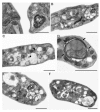TrypanocidalActivity of Natural Sesquiterpenoids Involves Mitochondrial Dysfunction, ROS Production and Autophagic Phenotype in Trypanosomacruzi
- PMID: 30373326
- PMCID: PMC6278339
- DOI: 10.3390/molecules23112800
TrypanocidalActivity of Natural Sesquiterpenoids Involves Mitochondrial Dysfunction, ROS Production and Autophagic Phenotype in Trypanosomacruzi
Abstract
Chagas disease is a neglected tropical disease that is caused by the protozoan Trypanosomacruzi and represents a serious health problem, especially in Latin America. The clinical treatment of Chagas disease is based on two nitroderivatives that present severe side effects and important limitations. In folk medicine, natural products, including sesquiterpenoids, have been employed for the treatment of different parasitic diseases. In this study, the trypanocidal activity of compounds isolated from the Chilean plants Drimys winteri, Podanthus mitiquiand Maytenus boaria on three T. cruzi evolutive forms (epimastigote, trypomastigote and amastigote) was evaluated. Total extracts and seven isolated sesquiterpenoids were assayed on trypomastigotes and epimastigotes. Polygodial (Pgd) from D. winteri, total extract from P. mitiqui (PmTE) and the germacrane erioflorin (Efr) from P. mitiqui were the most bioactive substances. Pgd, Efr and PmTE also presented strong effects on intracellular amastigotes and low host toxicity. Many ultrastructural effects of these substances, including reservosome disruption, cytosolic vacuolization, autophagic phenotype and mitochondrial swelling (in the case of Pgd), were observed. Flow cytometric analysis demonstrated a reduction in mitochondrial membrane potential in treated epimastigotes and an increase in ROS production and high plasma membrane permeability after treatment with Pgd. The promising trypanocidal activity of these natural sesquiterpenoids may be a good starting point for the development of alternative treatmentsforChagas disease.
Keywords: Trypanosoma cruzi; autophagy; chagas disease; chemotherapy; mitochondria; sesquiterpenoids.
Conflict of interest statement
The authors declare no conflict of interest. The sponsors had no role in the design of the study; in the collection, analysis, or interpretation of data; in the writing of the manuscript, or in the decision to publish the results.
Figures






Similar articles
-
4-Nitrobenzaldehyde thiosemicarbazone: a new compound derived from S-(-)-limonene that induces mitochondrial alterations in epimastigotes and trypomastigotes of Trypanosoma cruzi.Parasitology. 2015 Jun;142(7):978-88. doi: 10.1017/S0031182015000141. Epub 2015 Feb 25. Parasitology. 2015. PMID: 25711881
-
Mammea type coumarins isolated from Calophyllum brasiliense induced apoptotic cell death of Trypanosoma cruzi through mitochondrial dysfunction, ROS production and cell cycle alterations.Bioorg Chem. 2020 Jul;100:103894. doi: 10.1016/j.bioorg.2020.103894. Epub 2020 May 1. Bioorg Chem. 2020. PMID: 32388434
-
A novel triazolic naphthofuranquinone induces autophagy in reservosomes and impairment of mitosis in Trypanosoma cruzi.Parasitology. 2012 Jan;139(1):26-36. doi: 10.1017/S0031182011001612. Epub 2011 Sep 23. Parasitology. 2012. PMID: 21939585
-
In silico study of structural and geometrical requirements of natural sesquiterpene lactones with trypanocidal activity.Mini Rev Med Chem. 2013 Aug;13(10):1407-14. doi: 10.2174/13895575113139990066. Mini Rev Med Chem. 2013. PMID: 23815577 Review.
-
Different cell death pathways induced by drugs in Trypanosoma cruzi: an ultrastructural study.Micron. 2009 Feb;40(2):157-68. doi: 10.1016/j.micron.2008.08.003. Epub 2008 Sep 4. Micron. 2009. PMID: 18849169 Review.
Cited by
-
Comparative Study of Bioactivity and Safety Evaluation of Ethanolic Extracts of Zanthoxylum schinifolium Fruit and Pericarp.Molecules. 2021 Sep 29;26(19):5919. doi: 10.3390/molecules26195919. Molecules. 2021. PMID: 34641463 Free PMC article.
-
Oxidation of Isodrimeninol with PCC Yields Drimane Derivatives with Activity against Candida Yeast by Inhibition of Lanosterol 14-Alpha Demethylase.Biomolecules. 2020 Jul 24;10(8):1101. doi: 10.3390/biom10081101. Biomolecules. 2020. PMID: 32722158 Free PMC article.
-
Antifungal Effects of Drimane Sesquiterpenoids Isolated from Drimys winteri against Gaeumannomyces graminis var. tritici.Appl Environ Microbiol. 2020 Nov 24;86(24):e01834-20. doi: 10.1128/AEM.01834-20. Print 2020 Nov 24. Appl Environ Microbiol. 2020. PMID: 33036992 Free PMC article.
-
Plant Terpenoids as Hit Compounds against Trypanosomiasis.Pharmaceuticals (Basel). 2022 Mar 10;15(3):340. doi: 10.3390/ph15030340. Pharmaceuticals (Basel). 2022. PMID: 35337138 Free PMC article. Review.
-
Inhibitory Potential of the Drimane Sesquiterpenoids Isotadeonal and Polygodial in the NF-kB Pathway.Molecules. 2025 Mar 31;30(7):1555. doi: 10.3390/molecules30071555. Molecules. 2025. PMID: 40286191 Free PMC article.
References
-
- WHO Expert Committee on the Control of Chagas Disease (Brasilia, Brazil) & World Health Organization Control of Chagas Disease: Second Report of the WHO Expert Committee (Geneva) [(accessed on 24 May 2018)]; Available online: http://www.who.int/iris/handle/10665/42443.
MeSH terms
Substances
LinkOut - more resources
Full Text Sources
Miscellaneous

